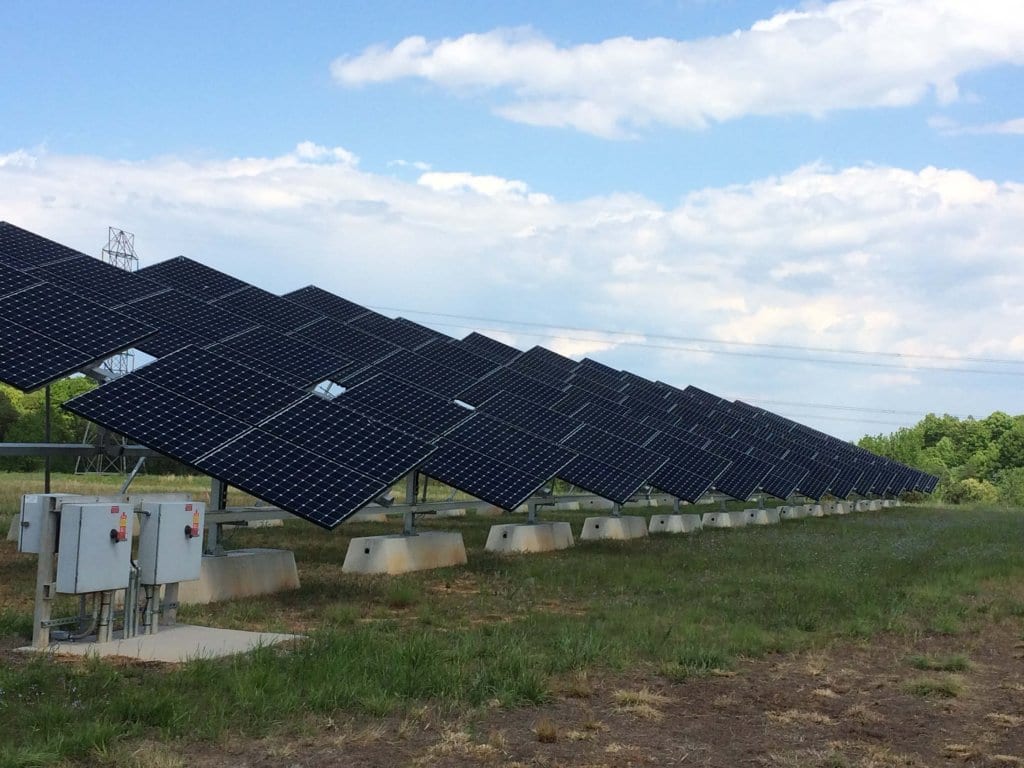Solar tracker systems don’t actually need to track the sun so dutifully. Here’s the math to prove it.
By: Adam Baker
Some of the dialogue about how important it is for trackers to accurately follow the sun isn’t entirely valid. I want to explain why with a little math.

What most people think about solar tracking system movements
It seems reasonable you would want all your modules pointed as close to the trajectory of the sun across the sky as possible, right? In reality, you have a solar tracking system actuator motor, periodically moving trackers forward across the path of the sun to try and keep it relatively close.
But is that really necessary?
Small solar tracking system movements don’t actually provide more energy
I’m not sure if you’ve ever sat down and done the math like I have, but you actually don’t need to follow the sun that closely.
If you take the cosign of the angle between where the sun is located, and where the module is pointed, that gives you the ratio of the surface area of the module as it’s pointed to the sun. If the module and sun are in exact alignment (cosign of 0 degrees = 1), you get the full module pointed exactly at the sun.
However…
A small angle gives you a very small cosign. If the angle were 2.5 degrees, you still get 99.9% of the module’s surface exposed directly to the sun. To configure the module to start at 2.5 degrees behind the sun, and move 5 degrees forward past the sun will still keep you within 99.9% of the maximum energy that module would be able to produce.
We know the sun moves 360 degrees around the earth every 24 hours, which means it moves a quarter of a degree every minute, 15 degrees per hour, east to west.
Calculating in the sun’s quarter of a degree movement per minute, a 5-degree tracker move every 20 minutes will keep the module’s orientation at that 99.9% energy transfer.
But we’re not done yet.
How DC/AC ratio plays into tracker optimization
On a fixed site, the DC/AC ratio might be 1.25-1.3, meaning that for each 1MW inverter, there will be 1.25-1.3 MW of DC solar panels behind it. Tracker sites keep the DC/AC ratio a little lower than that.
If we assume we have a 1.1-1.15 DC/AC ratio at our tracker site, that means we have 150kw of extra solar behind each 1MW inverter. To make our calculation a little more accurate, let’s take into account some of the losses you’ll have when collecting DC energy.
- 1% Mismatch Loss: if you have 325 watt panels, some will be 325.1 watts, some will be 325.7 watts, and others will be 328 watt modules.
- 1% I2R Loss: these are losses of power from current flowing through the conductors, which have a very small amount of resistance in them.
- 1%-3% Soiling Loss: dirt, pollen, and other environmental contaminates accumulate on the surface of modules.
Total: 5% loss of DC power before it gets to the inverter.
How often should you move your solar tracking system?
Even after removing this 5% energy loss, you’ll still have an extra 5%-10% of DC behind the inverter (remember: your DC/AC ratio is 1.1-1.15). If you calculate the angle in order to keep this additional loss at 5% or less, it gives you 18 degrees. The cosign of 18 degrees is .95. That’s 95% of the energy at 18 degrees of difference between where the sun is and where the panel is!
Here’s where it gets cool.
A 36 degree move from 18 degrees behind the sun to 18 degrees ahead of the sun, would only be one move every 2.5 hours! 2.5 hours!
If you’re trying to continuously move your panels to track as close to the sun as possible in 1, 5, or 10 minute increments, I argue (with math) that those continuous movements are a waste of tracker actuator energy (and bearings).
You can move your panels as far out as once per hour, while still collecting 95% to 97% of the energy. That energy is in excess of the inverter anyway, so you’re not even losing anything moving every two hours. That of course, assumes it’s a clear sky day. If it’s a cloudy day, you’ll want to be a little closer to the sun.
Adam Baker
Adam Baker is Senior Sales Executive at Affinity Energy with responsibility for providing subject matter expertise in utility-scale solar plant controls, instrumentation, and data acquisition. With 23 years of experience in automation and control, Adam’s previous companies include Rockwell Automation (Allen-Bradley), First Solar, DEPCOM Power, and GE Fanuc Automation.
Adam was instrumental in the development and deployment of three of the largest PV solar power plants in the United States, including 550 MW Topaz Solar in California, 290 MW Agua Caliente Solar in Arizona, and 550 MW Desert Sunlight in the Mojave Desert.
After a 6-year stint in controls design and architecture for the PV solar market, Adam joined Affinity Energy in 2016 and returned to sales leadership, where he has spent most of his career. Adam has a B.S. in Electrical Engineering from the University of Massachusetts, and has been active in environmental and good food movements for several years.

